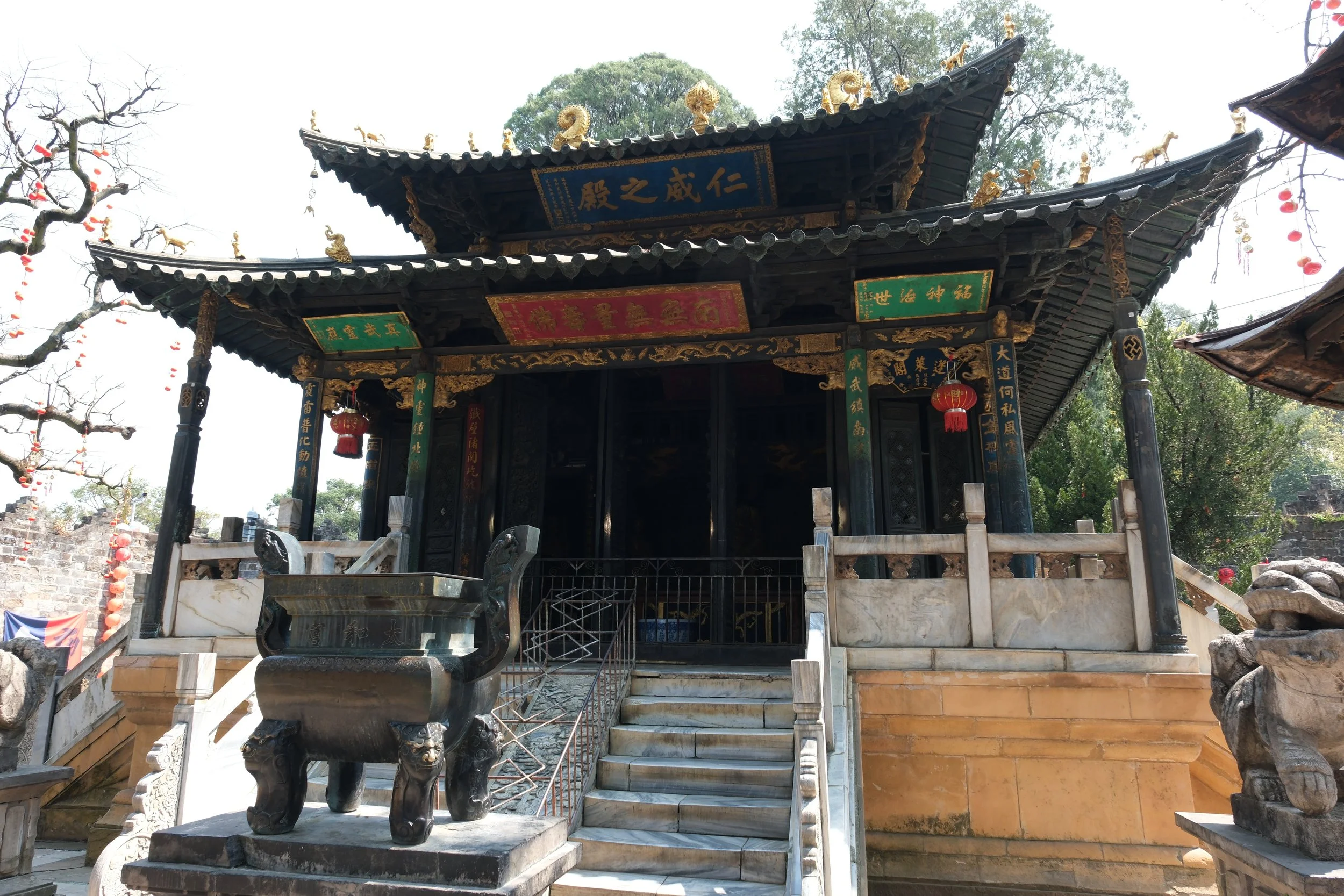Kunming’s Golden Temple 昆明金殿
The entire temple – I guess “pavilion” might be more accurate – is built of bronze. The tree just poking its branches into view on the left is also said to date back to the seventeenth century
About five kilometres northeast of downtown Kunming, the little Golden Temple (金殿) sits inside a small citadel on a forested ridge of the Minsheng hills. Built entirely from gilded bronze – pillars, rooftiles, eaves, wall panels, decorative brackets, the lot – it’s dedicated to Zhenwu (真武), the “True Warrior” and deity of the north, and symbolically protects the city from hazards approaching from this direction.
Depicted as a long-haired swordsman with a pot belly, Zhenwu started life as a rogue fragment of the Jade Emperor. According to Journey to the North (北游记), Zhenwu’s sixteenth-century biography, he suffered multiple human incarnations in an attempt to purify himself of desire, finally achieving enlightenment in the form of a Daoist warrior with unbound hair – so fixing his eternal appearance. Meanwhile his stomach and entrails had escaped and transformed into an evil turtle and snake, which caused havoc until Zhenwu forced them to join his demon-hunting crusade. His feet are usually shown resting on these reptiles, symbolising his ability to suppress troublesome spirits.
The Golden Temple has a complex history. The fifteenth-century original on which it was modelled (known as 太和宮, the “Palace of Supreme Harmony”), occupies the summit of Wudang mountain in Hubei province, the traditional centre of Zhenwu’s cult. In 1593, Chen Yongbin (陈用宾) became governor of Yunnan; an Imperial degree holder, he was also a military strategist who successfully suppressed local disturbances and allied with neighbouring Siamese kingdoms to combat Burmese intrusions into Yunnan.
In 1602 Chen Yongbin diverted a shipment of bronze intended for minting coins and instead used it to build a replica of Wudang Shan’s temple at Kunming. As Zhenwu is a martial deity it’s not surprising that Chen, with his military leanings, decided to honour this god.
Zhenwu, the True Warrior, Emperor of the North (北帝) and Emperor of the Dark Heavens (玄天上帝; black is symbolically associated with north). The red board reads something like “Benevolence and Justice”. Again, everything in view is made of bronze
But then in 1636 Mu Yi (木懿), the powerful ruler of Lijiang in northwest Yunnan, put down a rebellion for the Chinese government. Partly in gratitude, he was allowed to relocate the Golden Temple – which he felt would increase his family’s fortunes – to within his own territory on holy Jizu Shan, Chickenfoot Mountain (which you can read all about here).
Just eight years later the Ming dynasty collapsed: the last emperor hanged himself and Beijing was occupied by the forces of imperial hopeful Li Zicheng (李自成). At the same time, Manchu armies were lapping at the Great Wall, held at bay by general Wu Sangui (吳三桂). With no emperor left to defend Wu sided with the invaders and let the Manchus through the wall. They kicked out Li Zicheng, occupied Beijing, and founded the Qing dynasty.
What are claimed to be Wu Sangui’s weapons on display, along with nineteenth-century photo giving an idea of their size
While the Manchus were busy securing their hold on eastern China, Wu Sangui was made overlord of the far southwest of the country. He set up base at Kunming, where in 1671 – as a military man himself – he had the current Golden Temple cast, using some 250 tons of bronze. A museum in one of the halls displays what is claimed to be Wu Sangui’s halberd and 1.94m-long, two-handed seven-star longsword weighing 48kg, which used to hang in the temple as a symbol of Zhenwu’s might.
In 1673 the Manchu Qing dynasty, now secure in their hold over most of China, decided to retire Wu Sangui and take direct control of the southwest. Unwilling to leave his fiefdom, Wu launched “The Revolt of the Three Feudatories” but died campaigning in 1678; his forces were defeated two years later.
For the extraordinary story of how his concubine Chen Yuanyuan escaped the subsequent slaughter and settled with her children in a remote valley in Guizhou, where Wu Sangui’s descendants hid in complete anonymity until the 1980s, check out my 2018 article in the South China Morning Post.


